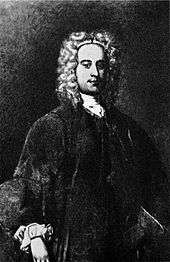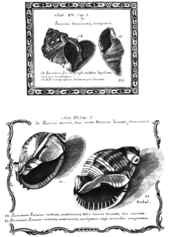- Martin Lister
-
Martin Lister FRS (12 April 1639 - 2 February 1712) was an English naturalist and physician.
Contents
Life
Lister was born at Radcliffe, near Buckingham, the son of Sir Martin Lister MP for Brackley in the Long Parliament and his wife Susan Temple daughter of Sir Alexander Temple. Lister was connected to a number of well known individuals. He was the nephew of both James Temple, the regicide and also of Sir Matthew Lister, physician to Anne, queen of James I, and to Charles I. He was also the uncle of Sarah Churchill, Duchess of Marlborough.
Lister was educated at Melton, Leicestershire under Mr Barwick and matriculated at St John's College, Cambridge in 1658. He graduated in 1658/9, and was elected a fellow in 1660.[1] In 1668 he travelled to France to study as a physician and settled at York in 1670 to practice medicine.[2] He became Fellow of the Royal Society on 2 November 1671. He practised medicine at York until 1683, when he removed to London. In 1684 he received the degree of M.D. at Oxford on the recommendation of the Chancellor.[2] In 1687 became F.R.C.P.. He attended the Earl of Portland when he was ambassador to France in 1698. He was physician to Queen Anne from 1709 until his death.[2]
Martin contributed numerous articles on natural history, medicine and antiquities to the Philosophical Transactions. His principal works were Historiae animalium Angliae tres tractatus (1678); Historiae Conchyliorum (1685 1692), and Conchyliorum Bivalvium (1696). As a conchologist he was held in high esteem, but while he recognized the similarity of fossil mollusca to living forms, he regarded them as inorganic imitations produced in the rocks.
In 1683 he communicated to the Royal Society (Phil. Trans., 1684), an ingenious proposal for a new sort of maps of countries; together with tables of sands and clays, such as are chiefly found in the north parts of England. In this essay he suggested the preparation of a soil or mineral map of the country, and thereby is justly credited with being the first to realize the importance of a geological survey.
Lister bought Carlton Hall in Craven in the West Riding of Yorkshire. He died at Epsom at the age of 72 and was buried at Clapham Church.[1]
He was a benefactor of the Ashmolean Museum in Oxford.[2] The ridge Dorsa Lister on the Moon was named after him.
Publications
- Histories Animalium Angliae tres tractatus, &ct,, l678.
- Goedartii Historia Insectorum cum notis,,, 1682.
- De Fontibus medicinalibus Angliae,,, l682.
- Historiae Conchyliorum, 1685
- Exercitatio Anatomica, in qua de Cochlcis agitur,,, 1694.
- Cochlearum ct Linacum exercitatio Anatomica,,, 1695.
- Conchyliorum bivalvium utriusque aquae exercitatio Anatomica tertia,,, 1696.
- Exercitationes Medicinales, &tc,,. 1697.
- Journey to Paris, c 1699
See also
Historiae animalium, by Conrad Gesner
References
- ^ a b Lister, Martin in Venn, J. & J. A., Alumni Cantabrigienses, Cambridge University Press, 10 vols, 1922–1958.
- ^ a b c d Royal Society (Great Britain), Charles Hutton The Philosophical transactions of the Royal Society of London, Volume 1
Bibliography
- Dr. Martin Lister: A bibliography by Geoffrey Keynes. (Includes illustrations by Lister's wife and daughter). Published by St Paul's Bibliographies (UK) with an ISBN 0 906795 04 4
 This article incorporates text from a publication now in the public domain: Chisholm, Hugh, ed (1911). Encyclopædia Britannica (11th ed.). Cambridge University Press.
This article incorporates text from a publication now in the public domain: Chisholm, Hugh, ed (1911). Encyclopædia Britannica (11th ed.). Cambridge University Press.
External links
- Historiae Conchyliorum, Vol. 1 and 2 (1685) - digital facsimile, Linda Hall Library
Categories:- Scientists connected with York
- 1639 births
- 1712 deaths
- 17th-century English medical doctors
- 18th-century English medical doctors
- English naturalists
- English geologists
- Fellows of the Royal Society
Wikimedia Foundation. 2010.


